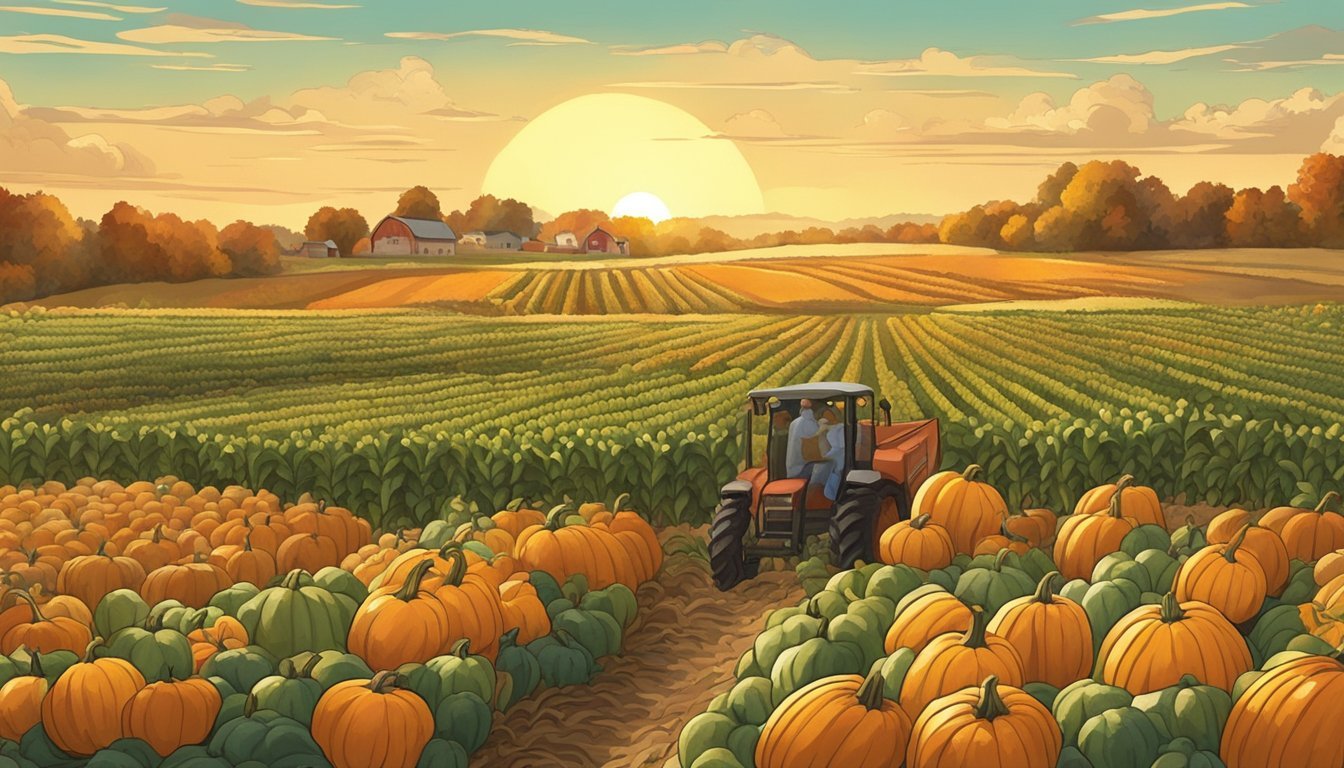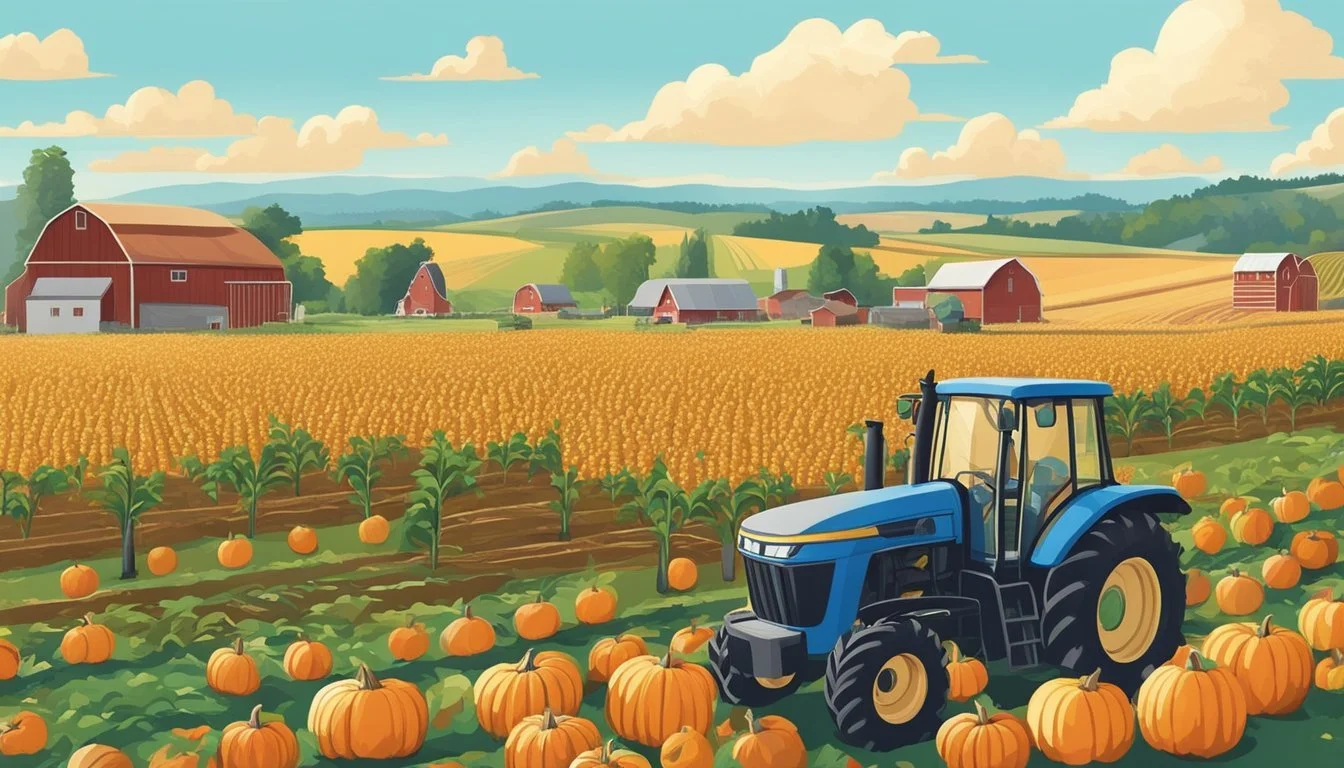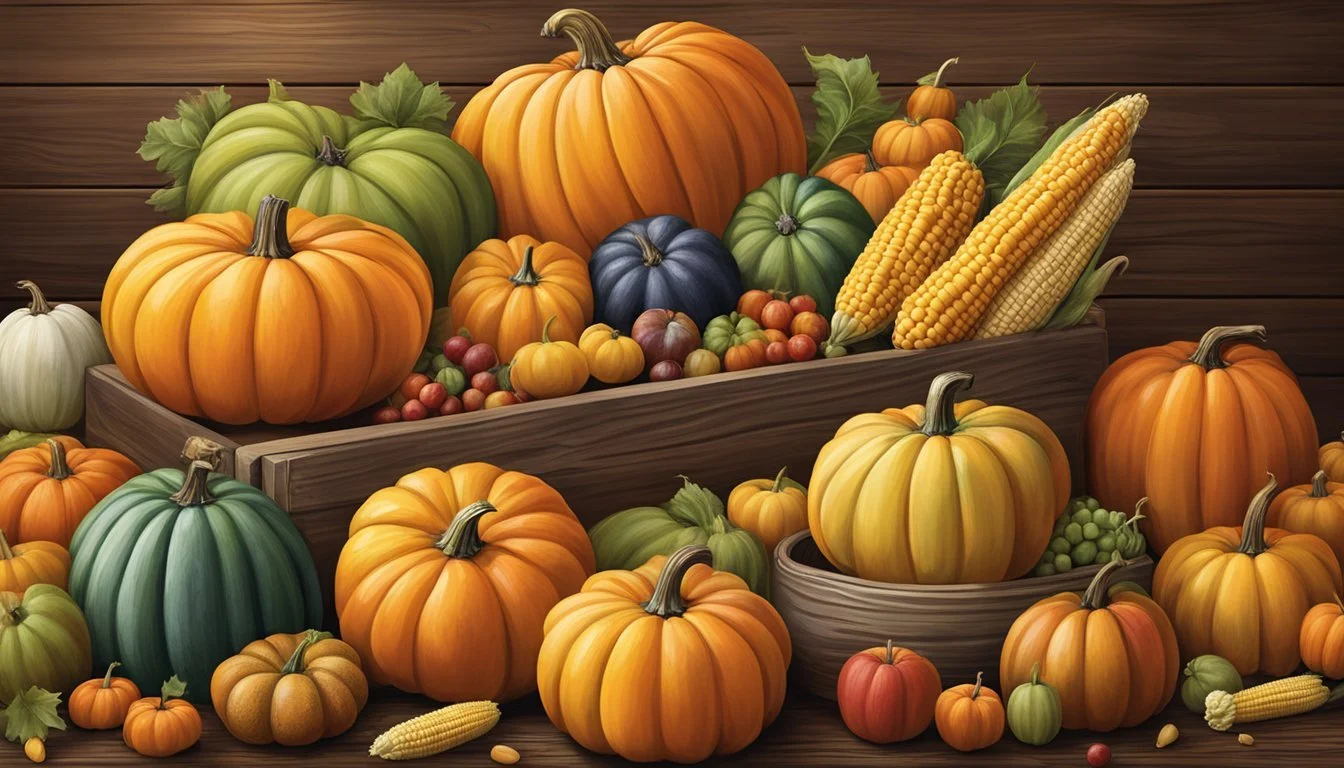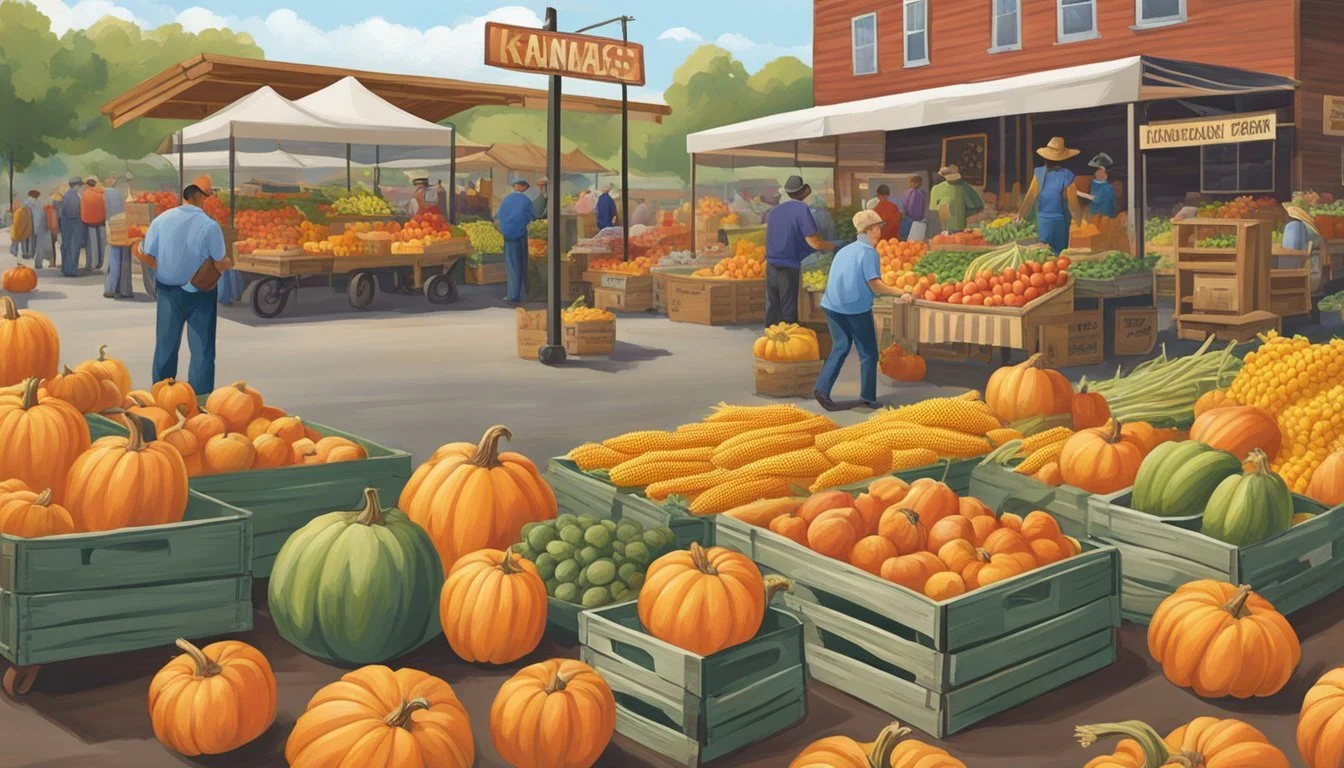Kansas Seasonal Fruit & Vegetables in October
A Guide to Autumn Harvest
This Article is Part of our Kansas Seasonal Fruit & Veg Calendar
October in Kansas marks a time of transition as the state embraces the fall season, with trees showing off vibrant leaves and harvests reaching their peak. This month is particularly significant for local produce since a variety of fruits (What wine goes well with fruit?) and vegetables are at their ripest, ready to be picked and savored. From the orchards to the fields, the agricultural richness of Kansas becomes evident through the abundance of fresh produce available.
The fall harvest brings a bounty that includes crisp apples, earthy root vegetables, and a medley of squashes that are quintessential to the season. October's cooler temperatures and shorter days contribute to the sweetening of apples and the maturation of various squashes. Farmers markets and grocery stores across the state are teeming with these seasonal offerings, reflecting the local agricultural practices that prioritize freshness and quality.
Eating seasonally in Kansas during October not only supports the local farming community but also ensures that residents enjoy produce with maximum flavor and nutritional value. The seasonal fruits and vegetables picked at the height of their ripeness promise a taste that is unmatched, embodying the essence of fall in Kansas. Moreover, these autumnal months are an ideal time for locals and visitors to experience the state's agricultural heritage through pumpkin patches, apple orchards, and harvest-themed events.
Overview of Kansas Seasonal Produce
In Kansas, October's seasonal bounty is rich with a variety of produce, marking a period where the fall harvest presents its final crescendo. This month provides an abundant choice of both fruit and vegetables, symbolizing the transitional essence of autumn.
Fruits available in October are typically the tail end of summer sweetness and the beginning of fall's robust flavors. Apples take center stage, with various types reaching peak ripeness. Pears also feature prominently in the seasonal selection, alongside late-season berries that bring a hint of summer past.
The vegetable selection in October is marked by hearty and versatile offerings. Root vegetables like sweet potatoes and turnips are harvested, ready for comforting autumnal dishes. Winter squashes, including butternut and acorn, provide rich, sweet flavors that are ideal for both savory and sweet preparations. Green offerings such as Brussels sprouts and spinach remain available, reflecting fall's cooler but still nurturing climate.
Here's a breakdown of Kansas's seasonal produce in October:
Vegetables Fruits Sweet potatoes Apples Turnips Pears Brussels sprouts Late-season berries Spinach Winter squashes (e.g., butternut, acorn)
Consumers can revel in the fresh, local harvest, knowing these items have been cultivated to coincide naturally with the season's rhythm. The array of colors, textures, and tastes available during this period provides a testament to the agricultural diversity that Kansas soil nurtures through the fall season.
Fruit Harvest in October
In October, Kansas celebrates the harvest of several key fruits, each bringing its own unique flavors to the table. This period marks an ideal time for consumers to visit local farms and partake in the seasonal bounty.
Apples
October is prime time for apple picking in Kansas. One can find a variety of apples ripe for the picking, which are perfect for eating fresh or using in recipes such as pies and jams. Local farms typically offer a range of apple types, from the tart Granny Smith to the sweet Honeycrisp.
Pears
Pears also reach their peak in October. These fruits are often celebrated for their soft, buttery texture and are versatile in use, from fresh snacking to baked goods. Like apples, pears can be stored for an extended period, making them a lasting staple of the fall season.
Grapes
Grape harvest can extend into October, with vineyards bustling as the fruit is picked for table consumption, jams, and local wine production. Kansas grapes contribute robust flavors to the state's burgeoning local wine scene and are a testament to the diverse agricultural capabilities of the region.
Vegetable Harvest in October
October in Kansas sees a bountiful harvest, with various vegetables reaching their peak. Root vegetables, pumpkins, and squash, as well as a variety of greens, are widely available from local farms.
Root Vegetables
In the chill of fall, root vegetables thrive in Kansas. Carrots and beets (how long do beets last?) are particularly notable, harvested frequently during this month.
Carrots: Packed with nutrients, these are available fresh from the fields.
Beets: Rich in color and flavor, beets are harvested before the first deep frost sets in.
Local farmers often offer these vegetables at markets, with carrots also coming from storage to ensure a steady supply.
Pumpkins and Squash
Pumpkins and squash signify the essence of fall and are central to the October harvest in Kansas.
Pumpkins: From vibrant jack-o'-lanterns to varieties suited for pies, they are a staple.
Squash: With types like butternut and acorn, squash is versatile in culinary use.
These are found at local pumpkin patches and farms, offering a festive pick-your-own experience or pre-harvested options.
Greens
Even as the temperatures drop, greens flourish, offering a fresh taste even late into the year.
Kale and spinach: They remain hardy and are often grown in protected environments to extend their availability.
Farmers employ techniques like hoop houses to keep these nutritious greens on tables well into the fall season.
Harvesting Techniques
In Kansas, various harvesting techniques are employed on farms during October to ensure the optimal quality and longevity of the produce. For fruits like apples, growers often use hand-picking methods to avoid bruising. Apples are carefully twisted and lifted from the branch, not pulled, to prevent damage to the fruit and the tree.
For root vegetables such as carrots, mechanical harvesters may be utilized, although smaller farms could choose hand-harvesting. These root crops are typically loosened from the soil using a spade or a specialized digging fork before being pulled out.
Vegetables with foliage like broccoli and brussels sprouts require a sharp knife to cut the mature head from the plant. It is vital that the cut is clean to prevent the spread of disease and maintain the plant's health for possible subsequent harvests.
Here's a brief overview of the techniques:
Apples: Twist and lift from the branches.
Root Vegetables (e.g., Carrots): Use a spade or digging fork to loosen, then pull by hand.
Foliage Vegetables (e.g., Broccoli): Cut the mature head with a sharp knife.
Farmers must also monitor the crops closely and choose the right time for harvest to ensure vegetables and fruits reach peak ripeness. This involves understanding the subtle changes in color, texture, and sometimes the ease with which fruit can be picked. Proper harvesting techniques are crucial for maintaining produce quality and extending shelf life, which is incredibly important for market success and consumer satisfaction.
Seasonal Recipes
October in Kansas offers a bounty of fresh produce, perfect for creating heartwarming meals that capture the essence of autumn. Utilizing seasonal ingredients ensures peak freshness and optimal taste. Below are some recipe ideas for incorporating October's harvest into delightful dishes.
Roasted Butternut Squash Soup This classic soup brings out the natural sweetness of butternut squash. It's simply roasted with garlic and thyme, then pureed to create a creamy, comforting soup. A sprinkle of roasted pumpkin seeds (how long do pumpkin seeds last?) adds a delightful crunch.
Apple and Pear Tarts Ripe apples and pears from Kansas are excellent for baking. Thinly sliced and arranged on puff pastry, they make for a rustic tart, best served warm with a dollop of whipped cream or a scoop of vanilla ice cream.
Chard and Roasted Vegetable Salad Chard can be used as a robust base for a nutritious salad. Combine it with roasted root vegetables like beets and carrots, and toss in a homemade vinaigrette for a vibrant and healthy meal. Top with some goat cheese for added creaminess.
Herb-Crusted Pork with Apples Pork pairs beautifully with the flavors of October's apples. A pork loin, crusted with fresh herbs and served with sautéed apples, offers a perfect balance of savory and sweet.
Meal Type Key Ingredients Suggested Preparation Soup Butternut squash Roast, puree, season Dessert Apples, pears Bake in tarts Salad Chard, roasted vegetables Toss with dressing Main Course Pork, apples Roast pork, sauté apples
These recipes provide a starting point for exploring the range of delicious meals that can be prepared with Kansas's October produce.
Preparing and Storing Seasonal Foods
In October, Kansas provides a bountiful harvest, including items such as apples, pumpkins, and winter squash. It's important to handle and store these foods correctly to maximize their nutrition and shelf life.
Apples: They can be kept fresh in a cool, dark place for a few weeks. For longer storage, they should be refrigerated in a plastic bag to retain moisture. Before storing, one should ensure that the apples are dry and free from bruises to prevent spoilage.
Pumpkins: After carving or cooking, pumpkins can be stored in the refrigerator for a short time. For long-term storage, cooked pumpkin puree or cubes can be frozen in airtight containers.
Winter Squash: Squash has a hard rind, which allows it to last for months when stored in a cool, dry place, away from direct sunlight. However, once cut, it should be wrapped in plastic and refrigerated promptly.
Food Preparation Storage Nutrition Apples Wash and dry Cool, dark area or refrigerate Vitamin C, fiber Pumpkins Cook and puree Refrigerate or freeze Vitamins A and C, fiber Winter Squash Cook, can, or freeze Cool, dry place or refrigerate Vitamins A and C, antioxidants
For preservation methods, canning and freezing are effective for capturing nutrition and flavor. When canning, it is crucial to follow safe canning practices to prevent foodborne illnesses. Freezing is simpler; it involves portioning foods into meal-sized servings, using freezer bags or airtight containers, which helps maintain their nutritional value and quality.
Health Benefits and Nutrition
Eating a variety of fruits and vegetables in October offers numerous health advantages. Pumpkin, a seasonal favorite, not only provides a festive taste but also boosts immunity. Its nutritional content includes vitamins A and C, which are essential for a healthy immune system.
Beets, available from May through October in Kansas, are rich in fiber, folate, and manganese. They contribute to heart health and help with inflammation reduction. Similarly, cruciferous vegetables like broccoli, harvested until October, are high in vitamins K and C and have been linked to cancer prevention.
The prevalence of blackberries during this month means an intake of vitamin C and high levels of antioxidants which combat free radicals and promote skin health. These berries are also a good source of fiber, aiding digestion.
Sweet potatoes, packed with vitamin A, potassium, and beta-carotene, support eye health and the immune system. Their natural sweetness provides a healthier alternative to processed sugars.
Here is a breakdown of key fruits and vegetables available during October in Kansas and their associated health benefits:
Pumpkin: Immunity-boosting, liver cleansing
Beets: Heart health, anti-inflammatory properties
Broccoli: Rich in vitamins, cancer preventive benefits
Sweet potatoes: Eye health, immune system support
Blackberries: Antioxidant-rich, skin health, digestion aid
Consuming these foods close to the time of harvest ensures peak freshness, which can provide better taste and higher nutritional value. Therefore, individuals should be encouraged to include these seasonal products in their diets to maximize their health benefits.
Where to Buy Local Produce in Kansas
When looking for fresh, local produce in Kansas, there are several options for consumers. They can turn to various venues known for offering a broad selection of Kansas-grown fruits and vegetables, especially during the month of October.
Farmers Markets: Throughout Kansas, farmers markets are a prime choice for local produce. These markets typically offer a vibrant assortment of seasonal fruits and vegetables. To locate the nearest one, shoppers can refer to local listings or community boards.
Example Markets:
Overland Park Farmers' Market
Topeka Farmers Market
Local Farms: Directly visiting farms is another excellent way to purchase local produce. Farms often provide a "you-pick" experience, where customers can select their own produce right off the plant. This not only ensures freshness but also supports the local agricultural community.
Notable Local Farms:
Elderslie Farm in Wichita
Gasper Family Farm near Fort Scott
Specialty Shops: Specialty food shops in Kansas often feature products sourced from local farms. This can range from fresh fruits and vegetables to artisanal cheeses and meats.
LocalHarvest: An online resource, LocalHarvest, is a helpful tool for identifying nearby farms that offer a variety of produce and meats raised on native Kansan grasslands.
To summarize, Kansas boasts a wealth of options for sourcing local produce. Consumers are encouraged to support these local businesses, ensuring they enjoy the freshest food while contributing to the sustainability of their local economy.
Supporting Kansas Farms
Kansas residents have the opportunity to directly support local farms by purchasing produce during the peak harvest months. In October, a variety of fruits and vegetables reach their prime, offering the chance for consumers to enjoy fresh, locally grown produce while bolstering the state's agricultural economy.
Local Markets:
Farmers' markets and roadside stands abound throughout the state. These venues are perfect for finding fresh October crops like pumpkins, apples, and sweet potatoes. Supporting these markets not only aids in sustaining the farming community but also ensures fresher goods for consumers.
Community Supported Agriculture (CSA):
Participating in CSA programs is another excellent way of supporting Kansas farms. Members receive a share of the harvest, which could include:Broccoli
Brussels sprouts
Cabbage
Carrots
Seasonal Festivities:
Agricultural festivals and harvest celebrations also provide avenues for support, attracting visitors and residents alike. These events underscore the importance of the farming sector within Kansas.
State Programs:
The state encourages support for local farms through initiatives that highlight Kansas-produced goods. By purchasing products with a "Made in Kansas" label, consumers help maintain the state's farming legacy.
By choosing to support local Kansas farms, consumers contribute to the stability and growth of the agricultural community. Purchasing locally not only ensures the vitality of farms within the state but also promotes a more sustainable and robust food system for all Kansans.








